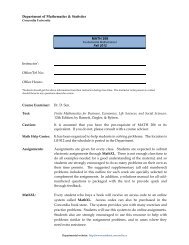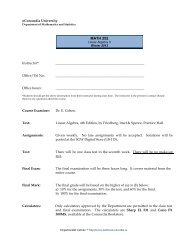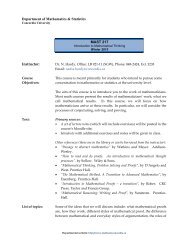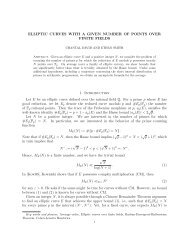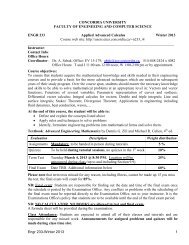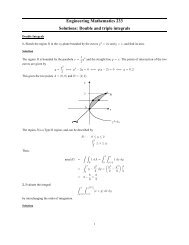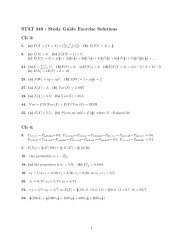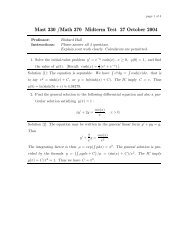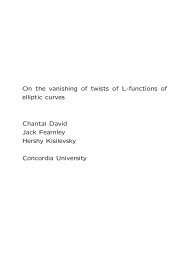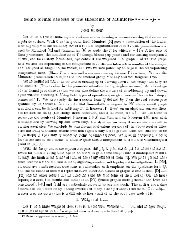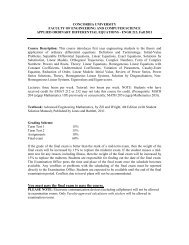COLOURINGS OF HYPERGRAPHS, PERMUTATION GROUPS ...
COLOURINGS OF HYPERGRAPHS, PERMUTATION GROUPS ...
COLOURINGS OF HYPERGRAPHS, PERMUTATION GROUPS ...
Create successful ePaper yourself
Turn your PDF publications into a flip-book with our unique Google optimized e-Paper software.
2 B. LAROSE AND L. HADDAD<br />
give various examples of both types of behaviour, and in [13] Haddad, Hell and<br />
Mendelsohn investigate this problem further.<br />
We now reformulate this decision problem in a more convenient form. Let A =<br />
{1, . . . , h}.<br />
• CSP (ρ G )<br />
Input: a relational structure 〈X; µ〉 where µ is h-ary;<br />
Question: is there a homomorphism from 〈X; µ〉 to 〈A; ρ G 〉 <br />
It is easy to see that in fact these problems are equivalent. Indeed, it is clear<br />
that if the input structure for CSP (ρ G ) is not areflexive then there cannot be a<br />
homomorphism. Furthermore, it is easy to verify that if a homomorphism exists,<br />
and if both (x 1 , . . . , x h ) and (x π(1) , . . . , x π(h) ) are in µ then π ∈ G. Finally, we can<br />
always add to µ all permutation of its tuples by permutations in G without changing<br />
the set of solutions. Obviously all these steps can be done in time polynomial in<br />
the size of the structure 〈X; µ〉 and thus we may safely restrict the inputs to the<br />
problem CSP (ρ G ) (abbreviated from now as CSP (G)) to areflexive structures with<br />
symmetry group G.<br />
More generally, for any finite set of relations R = {ρ 1 , . . . , ρ k } on A where ρ i has<br />
arity d i , let CSP (R) denote the following decision problem:<br />
• CSP (R)<br />
Input: a relational structure 〈X; µ 1 , . . . , µ k 〉 where µ i is d i -ary;<br />
Question: is there a homomorphism from 〈X; µ 1 , . . . , µ k 〉 to 〈A; ρ 1 , . . . , ρ k 〉 <br />
In 1993, Feder and Vardi [11] conjectured that, depending on the constraint<br />
relations, the problem CSP (ρ 1 , . . . , ρ k ) should be either in P or NP-complete.<br />
This dichotomy conjecture has attracted a great deal of attention lately (see for<br />
example [3, 4, 5, 7, 9, 12, 22, 23, 24, 25, 31]), and the conjecture has been settled in<br />
various special cases. A deep connection with universal algebra was uncovered by<br />
P. Jeavons [22] and further refined in collaboration with Bulatov and Krokhin [7, 8].<br />
They have stated a precise conjecture predicting which sets of relations should give<br />
rise to tractable problems and which are NP-complete (a conjecture along the same<br />
lines is sketched in [12].) We now state the precise conjecture and briefly outline<br />
the necessary background (we refer the reader to [20], [32] and [34] for basic results<br />
in universal algebra.)<br />
Let f be an n-ary operation on a set A and let θ be a k-ary relation on A. We<br />
say that f preserves θ or that θ is invariant under f if the following holds: given<br />
any matrix M of size k × n whose columns are in θ, applying f to the rows of M<br />
will produce a k-tuple in θ. Given a set R of relations on A, we define P ol(R) to<br />
be the set of all operations on A that preserve all relations in R. Jeavons observed<br />
that the complexity of the problem CSP (R) is essentially determined by P ol(R).<br />
Bulatov, Jeavons and Krokhin prove that, to settle the dichotomy conjecture, it<br />
is sufficient to consider sets of relations R such that every member of P ol(R) is<br />
surjective [7]. When a set of relations has this property we say that it is a core. 1<br />
An operation f on A of arity at least 2 is idempotent if it satisfies the identity<br />
f(x, . . . , x) ≈ x (where ≈ indicates the equality holds with all variables universally<br />
quantified). Equivalently, an operation on A is idempotent if it preserves every<br />
1 More precisely, we should say that the relational structure 〈A; R〉 is a core, i.e. that all its<br />
endomorphisms are automorphisms, see for instance [12] or [19]. Every finite relational structure<br />
has, up to isomorphism, a unique core, and the CSP problems for the structure and its core are<br />
poly-time equivalent [7].



